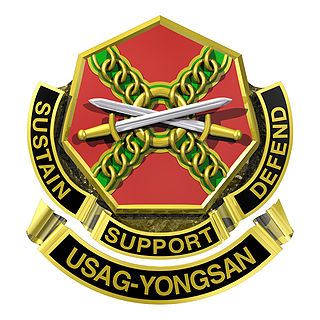
Yongsan Garrison, meaning "dragon hill garrison", is an area located in the Yongsan District of central Seoul, South Korea. The site served as the headquarters for U.S. military forces stationed in South Korea, known as United States Forces Korea (USFK), and as United States Army Garrison Yongsan (USAG-Yongsan) until 2018, under the supervision of the U.S. Army's Installation Management Command Pacific Region. From 1910 to 1945 it served as headquarters for the Imperial Japanese Army in Korea.

Yongsan Station is a major railway station in the Yongsan District of Seoul, South Korea. The station adjoins the Yongsan Electronics Market. The station is the terminus for high-speed and long-distance trains on a number of railway lines, including most trains on the Honam Line, its high-speed counterpart, and all trains on the Janghang and Jeolla Lines.
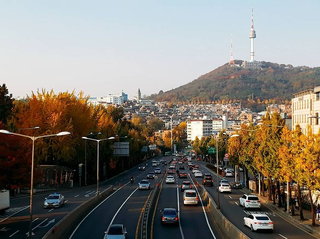
Yongsan District is one of the 25 districts of Seoul, South Korea.
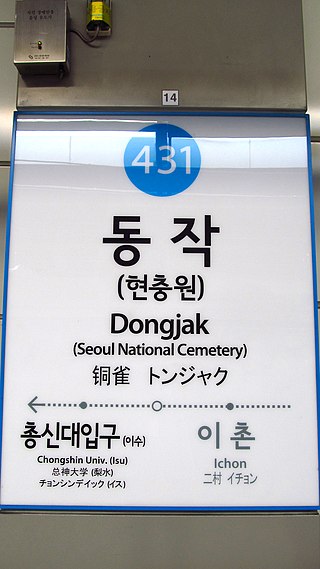
Dongjak Station is a station on Line 4 and Line 9 of the Seoul Subway. Express trains on Line 9 stop at this station. As the station's subname, This station serves the Seoul National Cemetery.

Hoehyeon Station (Korean: 회현역) is a station on the Seoul Subway Line 4. It is the closest station to the historical gate of Namdaemun, and also serves the major shopping district of Namdaemun Market. This station is located in Namchang-dong, Jung-gu, Seoul.

Naejangsan is a mountain located on the border of North Jeolla and South Jeolla provinces in southwestern South Korea, approximately three hours drive south of Seoul. It has an elevation of 763 m (2,503 ft).

Myeong-dong Station is a station on the Seoul Subway Line 4. This station is located in Jung-gu, Seoul.

Yongsan Electronics Market (Korean: 용산전자상가) is a retail area in Seoul, South Korea. Comprising over 20 buildings, housing 5,000 stores that sell appliances, stereos, computers and peripherals, office equipment, telephones, lighting equipment, electronic games and software, videos and CD's. A variety of electronic components for constructing computers and other items can also be found. Korean-made products generally cost 20% less here than other retail outlets, while imported items can be as much as 50% cheaper.

Sindorim station is a station on Seoul Subway Line 1 and Line 2 (underground). It is also the southeastern terminus of Line 2's Sinjeong Branch to Kkachisan. The station is located at the northern edge of Sindorim-dong, Guro-gu, Seoul, on the border with Yeongdeungpo-gu.

Ichon Station is a station in Yongsan-gu, Seoul on Seoul Subway Line 4 and the Gyeongui–Jungang Line. This station is the closest to the National Museum of Korea, situated in the interior of Yongsan Family Park. It also serves eastern Ichon-dong, home to the largest Japanese community in South Korea with some 1,300 Japanese residents.
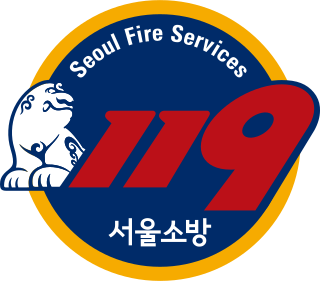
Seoul Metropolitan Fire and Disaster Management Headquarters is a department of the Seoul Metro government in charge of fire and rescue services in Seoul, South Korea.

Geumjeong Station is a ground-level metro station on lines 1 and 4 of the Seoul Subway network in South Korea. The station is in Gunpo, a city approximately 15 km (9.3 mi) south of Seoul in Gyeonggi Province, between the cities of Anyang and Suwon. The name means that the land is covered with waves everywhere and that the water wets women's clothes.

Nodeulseom an artificial island in the River Han in Seoul, South Korea. The uninhabited island is located to the east of the larger island of Yeouido. Hangang Bridge passes directly over the island.
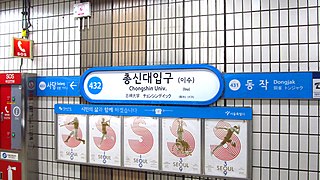
Isu Station is a subway station on the Seoul Subway Line 4 and Line 7 in Dongjak-gu, Seoul, South Korea.

Samgakji Station is a subway station on the Line 4 and Line 6 of the Seoul Metropolitan Subway. The Seoul War Memorial is a short walk away from exits 11 and 12. This station is on the west end of the Yongsan Garrison, which is a short walk from exit 13. Although not connected to this station by a transfer passageway, Namyeong station on Line 1 is a short walk from here.
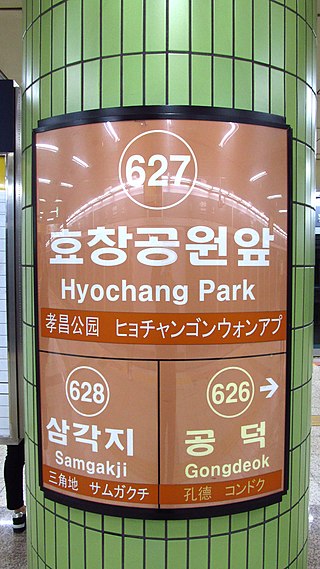
Hyochang Park Station is a subway station on Seoul Subway Line 6 and the Gyeongui–Jungang Line. It is named after Hyochang Park. Nearby is the Hyochang Stadium, a small field capable of hosting sports events. The Yongsan District Office is also nearby.

Noksapyeong Station is a subway station on the Seoul Subway Line 6. It is located on the eastern end of the Yongsan Garrison, and the western end of Itaewon. It is the main station servicing the Haebangchon and Hoenamu-gil communities, which are known for having significant foreign populations.
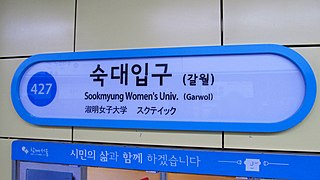
Sookmyung Women's University Station is subway station 427, on the Seoul Subway Line 4 in Yongsan-gu, Seoul. It is also called Garwol station (갈월역). It is located in front of the main entrance of the Sookmyung Women's University. There are many restaurants in the neighborhood of the subway station.

Hangangno-dong is a dong, neighbourhood of Yongsan-gu in Seoul, South Korea.
The Yongsan bombing by the United States Air Force took place during the North Korean offensive of the Korean War and included a destructive bombing raid in Seoul. About 50 B-29s with the U.S. Fifth Air Force bombed Yongsan, Seoul on 16 July 1950. The B-29s dropped bombs on the switch yard and arsenal behind the Yongsan Station to slow down the North Korean army advance; however, some of the bombs missed the targets and hit civilian facilities. Some 1,587 citizens were killed representing 58.6% of the total civilian casualties. The South Korean Truth and Reconciliation Commission declined to investigate the incident, calling the bombing operation a military necessity.




















